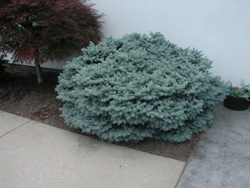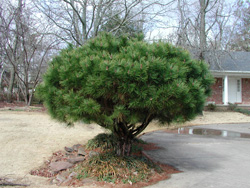Resource Library
Plant of the Week: Witch's-broom
The University of Arkansas System Division of Agriculture does not promote, support or recommend plants featured in "Plant of the Week." Please consult your local Extension office for plants suitable for your region.
Plant of the Week
Witch's-broom

With hundreds of years of gardening history under our collective belt, we gardeners have accumulated a wealth of trophies to show off in our gardens. One broad group of these is the dwarf plants grown from naturally occurring witch's-brooms. Witch's-brooms, though most commonly associated with conifers such as the pines and spruces, can occur in any woody plant.
A witch's-broom is an abnormal cluster of growth that forms somewhere among the branches of an otherwise normal-looking tree. The typical witch's-broom is characterized by excessive branch production, short stems and usually leaves or needles that are one-fourth to one-half those found on the normal part of the tree.
The causes for these abnormalities are many but are primarily thought to be associated with a stress-induced genetic change in the genome. The stressor is sometimes an insect (usually aphids or mites) or a plant pathogen such as fungi, bacteria, viruses or phytoplasmas. Because witch's-brooms are usually rare and widespread in nature, the pathogens causing them must not be very virulent or very easily transmitted by vectors.
Two bits of evidence provide credibility that this dwarfism is associated with a change at the DNA level. First, afflicted plants never grow out of the condition, even if grafted on normal seedlings. Secondly, this dwarfism is transmitted to future generations by seed at about the 50 percent rate.
The rate of dwarfism varies considerably. Some, such as an especially slow-growing form of hemlock, produce only one-fourth of an inch of shoot growth per year while others may make 2 to 4 inches. The growth form can also vary. While the round ball form is most common, some witch's-brooms produce prostrate spreaders, weepers or narrow upright branching forms.

The principle characteristics of a witch's-broom—increased branching and dwarfism—indicate that the plant's hormonal biochemistry is being disrupted. Though this has never been illustrated as far as I know, there is probably a significant increase in the cytokinin content (a plant hormone known to promote branching), and a reduction in production or a blockage in the activity of auxin, a phytohormone needed for normal cell expansion and growth.
Witch's-brooms have been observed for centuries. The term itself is taken from German hexenbesen—literally a hex put on a broom. In the forest, these clumps of foliage were thought to be the lair of witches, elves, hobgoblins, and mares (an evil spirit that would sit on your chest at night and cause bad dreams or nightmares). It was not until the Victorians began climbing mountains in the mid-1800s and began building rock gardens that an interest developed in propagating these dwarf plants for use in these new kinds of gardens.
Because dwarf forms can be selected from the witch's-broom itself in the tree or from seedlings grown from a witch's-broom, the number of potential plants is enormous. One gardener boasts on the Web of having more than 2,000 different kinds of dwarf conifers! For a dwarf form to be in the nursery trade, the plant must make enough growth to produce a salable plant in at least a decade. Because of their slower growth rate and because many must be grafted, dwarf conifers are a part of the specialty nursery trade and tend to be pricey. Dwarf forms are especially common in pines, spruce, arborvitae and Chamaecyparis.
Dwarf conifers are ideal landscape plants because their small stature reduces the likelihood they will outgrow their allotted space. Because they are conifers they do best in at least six hours of direct sunlight a day and in a reasonably fertile, well-drained soil. Because they are so slow-growing, they must not be crowed by normal plants that will take advantage of their slowness and shade them out.
By: Gerald Klingaman, retired
Extension Horticulturist - Ornamentals
Extension News - February 12, 2010
The University of Arkansas System Division of Agriculture does not maintain lists of retail outlets where these plants can be purchased. Please check your local nursery or other retail outlets to ask about the availability of these plants for your growing area.